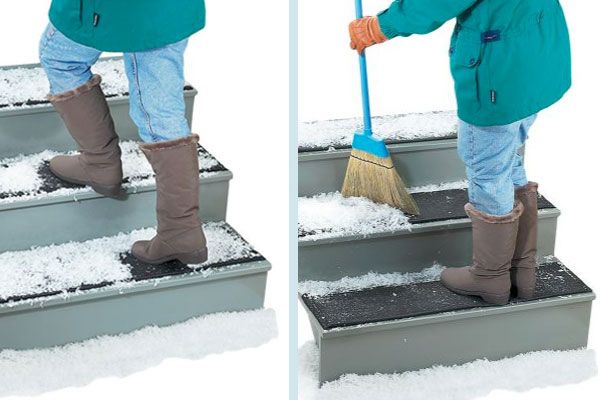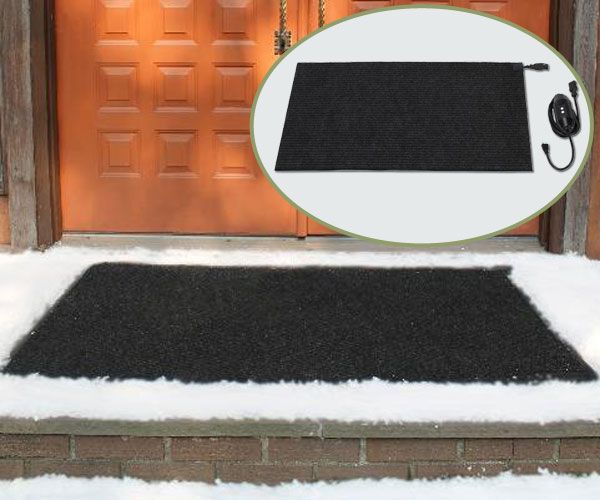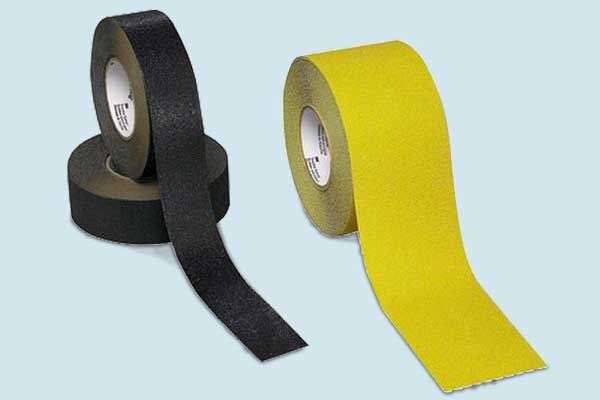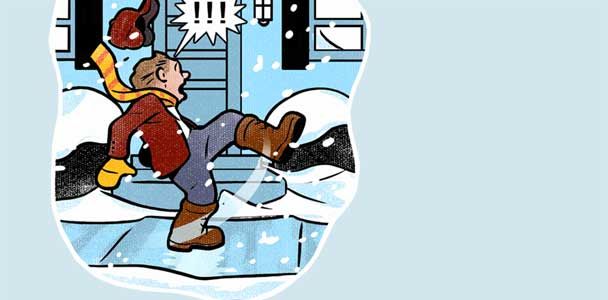We may be compensated if you purchase through links on our website. Our team is committed to delivering honest, objective, and independent reviews on home products and services.
The winter snow, ice, and slush can transform our outdoor spaces into treacherous terrain full of slippery spots. Deicing products can make your sidewalks and driveways safer, and there are a number of options out there that don’t use harsh chemicals. We’ll show you the tools and techniques you can use to make four key danger zones around your home less slick.
How To Prevent Icy Steps

With the uneven surface and pointed edges of icy stairs, a slip and fall could lead to serious injury. A chemical-free way to protect your visitors is a set of rubberized stair treads. These portable and cushy mats release ice with a stomp of the foot so you can brush it away.
To maximize the treads’ effectiveness, choose a size that covers the entire step surface, and check and clean them throughout the season so they keep their grip. While they can work just as well for temporary ice removal, such as for a party, you’ll get the most benefit from them by installing them before the first freeze of the season.
To try: Ice Breaker Mats, from $18
How To Prevent Icy Sidewalks

As people walk with heavy boots on a snowy sidewalk, its surface slowly gets covered with packed snow and ice. Many resort to traditional salt-based ice melts to keep their walkways safe and usable, but these can also damage concrete and be hard on vegetation.
A bag of traction granules made from volcanic minerals may solve your sidewalk, patio, deck, and driveway woes. These don’t actually melt the ice, but provide a gritty surface for more secure footing.
To use granules effectively, spread them evenly across the sidewalk. You may need to add more coats as necessary, especially after heavy snowfall, so keep a good supply on hand.
If you can’t find ice-removing granules, you can also use sand or fine gravel to do the job, though it may not stick as well to the ice in the long term.
To try: All-Natural Volcanic Mineral Ice Traction Granules, about $30 for a 20-pound bag, amazon.com
How To Keep Snow Off Your Front Entry

Keeping the area outside your front door free of ice is just as important. One chemical-free option is to use an electric ice-melting doormat. These products blend in with your front porch and run at low voltage to melt snow and ice on contact. They can even keep up with heavy snowstorms at a rate of about 2 inches melted per hour. All you need to do is plug them in and turn them on.
Just like rubber stair treads, you’ll get the most from your electric doormat by putting it down before the first snowfall. You’ll still need to shovel snow buildup adjacent to the mat and use it in conjunction with other deicing methods.
To try: HeatTrak 24-by-36-inch mat, from $160, heattrak.com
How To Keep Your Garage Floor From Getting Slippery

Garage floors can become particularly hazardous in winter, as melting snow and ice from vehicles make the inside surface slick. One solution is to use high-quality slip-resistant tapes and treads.
Apply the tape near workbenches, frequently-used storage areas, garage door openings, and entryways between your garage and the rest of your home. Press firmly so it sticks, and replace worn sections as necessary to keep the coating effective.
Besides tapes and treads, you can also add mats in high-traffic areas for larger-scale protection.
To try: Safety-Walk Slip-Resistant General Purpose Tape, about $64 for a 60-foot roll, shop3m.com
Additional Winter Safety Measures
While addressing specific areas is important, there are general practices that can enhance overall winter safety around your property:
Regular Snow Removal
Your first line of defense against winter hazards is consistent snow removal. Use a snow shovel or a snow blower to clear snow from your steps, stairs, walkways, and garage floors as soon as possible after a snowfall. Make sure to clear the snow all the way down to the surface to prevent a thin layer from turning into ice.
- Shovel snow in layers during heavy snowfall to avoid buildup
- Clear a wide enough path to allow for safe passage
- Pay special attention to high-traffic areas and stairs
Maintain Proper Lighting
Winter days are short, and poor visibility can increase the risk of slips and falls. Ensuring that your steps, stairs, walkways, and garage areas can improve the safety of these areas. Install or upgrade outdoor lighting to provide adequate illumination, especially in areas that may be shadowed or receive less natural light. Install motion sensor lights to illuminate potential hazards when it gets dark out.
- Use LED lights for energy efficiency and long-lasting illumination
- Regularly check and replace bulbs to ensure continuous lighting
Install Handrails and Non-Slip Treads
Handrails can provide support and prevent falls, especially on steps and stairs. If your steps or stairs do not have handrails, consider installing them before winter begins. Make sure railings are securely attached and easily graspable, even for people wearing gloves.
- Ensure handrails are securely fastened and extend the full length of the stairs.
- Regularly check and maintain handrails and treads to ensure they remain secure and effective.
When winter sets in, keep your shovels and ice melt close at hand. You don’t want to risk slipping and falling when you walk over to actually get the products.

